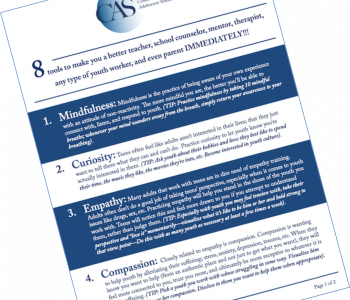

Sam Himelstein, PhD
Sam Himelstein is the founder and CEO of the Center for Adolescent Studies, Inc. He is passionate about working with youth and training the professionals that serve them.
4 Simple Tips to Creating Safety with Group Agreements
Creating a trusting environment is one of the most important keys to a successful group; whether it be a therapy group or in the traditional classroom setting (for the rest of this post I’m going to use the term “group” for the sake of non-redundancy. I use this term to refer to both therapy groups and traditional classrooms as they’re still groups of students). Higher self-disclosure, group content engagement, and overall cohesiveness find a large piece of their roots in trust. When students feel they can trust you and others in the room, more authentic engagement occurs.
But how do we create this safe space?
There are many factors (building authentic relationships is of course key), but what I’d like to focus on in this brief article is establishing group agreements.
Group agreements, sometimes referred to as group norms, other times as group expectations, and yet others (though less desirable as I write below) as group rules, aid in establishing a normative culture. This is a culture in which youth begin to develop a sense of respect, trust, and hopefully vulnerability. This type of normative culture is inherently therapeutic and benefits youth in either traditional classrooms or clinical groups. If done successfully (and this also heavily has do to with the youth in the groups, not just you as the facilitator establishing group agreements; i.e., cut yourself some slack if you try this and it doesn’t result in a highly trusting, cohesive group) there is the potential to offer the adolescents you work with a highly transformational experience. Consider for example, that in mainstream society right now we condition our young men to be anti-emotional (minus anger) and our young women to value superficial beauty over inner personal qualities. Creating a culture of trust and cohesiveness could work toward dismantling such conditioning. And again (sorry for the broken record but I repeat for emphasis), this could benefit youth in anything from a single gender therapy group to a mixed gender social studies class in a high school.
If you have the luxury, it’s best to present these agreements in your first group meeting. I know for some of you in the classroom setting, that time may have already passed and in such cases it’s okay to presence agreements later in the school year, just expect some resistance. In the Mindfulness-Based Substance Abuse 12-Session Curriculum I co-developed for example, we spend the better part of the whole first session discussing group agreements. This leads to myself having the ability to leverage those agreements throughout the 12 sessions, which leads to a more trusting and cohesive group.
So, I’d like to offer four simple tips for establishing group agreements during the first meeting. This isn’t an exhaustive list, but rather a guide to get you started in developing your normative, trusting group environment.
1) Agreements Vs. Rules
As I alluded to above, I’m not a fan of the phrase “group rules.” When presenting agreements for the first time to a group I often ask, “What’s the difference between rules and agreements?” To which the youth reply in some version or another, “When you break a rule, you get punished.” “That’s right. And when you step outside the bounds of an agreement, it’s more like a conversation. Like, ‘I thought we agreed to this. Do you still agree?’” I’d reply.
Conceptualizing agreements in this way distinguishes your group from the status-quo; that when someone makes a mistake they are automatically punished in some form. This leads to differentiating your group from every other group the youth are used to and has the potential to lead to a feeling of safety.
2) Develop Agreements With Your Group
Second, it’s important to develop a list of agreements with your group rather than coming in with pre-formulated agreements developed only by you. It’s completely okay to come in with an idea of what you’d like the agreements to involve, however they should be general (respect, no violence, one mic’ etc.) as to leave room for youth input. When you empower youth by letting them develop agreements, they will take more ownership and practice them more closely. Some common agreements I discuss with youth are:
- Respect (self and others)
- One mic’ (not talking when someone is talking)
- Skillful speech
- Skillful listening
- No violence
- Group refocusing technique
You might add others such as no phones out during group or no swearing depending on our context. Just remember, come in with a loose set of ideas and come to some agreement with the youth in the group.
3) Actually Get Everyone to Agree
It’s very easy to come up with a list of group agreements and treat them more like group rules. The key to effective agreements is actual youth acknowledgement. This suggests the importance of having dialogue with the group about each agreement; i.e., rather than saying “okay, so we agree that respect is one of our agreements, right?” And then just getting the feint-hearted nod and moving on to the next agreement, actually engage in a dialogue with the group about what respect means to each individual. This will help aid in getting everyone’s voice in the room and contribute to you, the facilitator, working with youth who might have definitions of respect that don’t align with the normative culture you’re attempting to create (a post on working with definitions of respect will be coming soon!). You could easily have a discussion on defining respect or turn it into a writing assignment for the youth in your class.
4) Group Agreements Can Be Activated In Any Moment
The first group isn’t the only time you’ll talk about agreements, and it’s good practice to expect agreements to get broken and prepare for those conversations. In more chaotic situations (larger classes, lots of disruptiveness, etc.) you may need to activate the agreements in any or every group. It’s best to think of the agreements as a living organism that can be brought into awareness at any moment. That’s why I emphasize the group refocusing technique when I presence agreements for the first time because it’s a great way to reset rambunctious energy and bring the group to a calm state where they can be reminded of the agreements.
Group agreements lead to normative, therapeutic culture. This culture leads to trust, cohesion, and vulnerability. Of course, other factors like group size, mixed gender, etc. play a role in normative culture, but having a foundational way of “being” helps further along these processes.
To learn more about building authentic relationships and trauma-informed care with youth as methods for building trusting environments and helping teens thrive, join the FREE Training Community, a growing professional network of helping professionals across disciplines. Dr. Sam Himelstein leads these monthly offering calls. To join him, register here!
Related Posts
2 Simple Tips to Create a Welcoming Trauma-Informed Classroom Space
4 Different Approaches to Leading Groups of Youth
9 Guidelines for Teaching Trauma-Informed Mindfulness to Teens
Mindful Classroom Management: A Tried-and-True Technique for Getting Youth Back on Track

